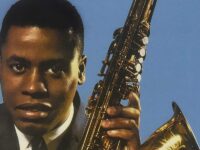During the 1964-68 period while he served as the “idea man” in Miles Davis’ Second Quintet, Wayne Shorter reeled off album after album under his own name that were extremely creative and sometimes breathtaking. Only another former Miles sideman bested him in the quality of recordings led by a tenor player during that same time frame.
Originals like “Footprints,” “Yes Or No,” “Infant Eyes,” and “Miyako” all made it into many a jazz player’s fake book and that’s not even counting the compositions he saved for just Davis’ band. Stylistically, Shorter effortlessly switched gears from advanced bop (Speak No Evil) to soul-jazz (Adam’s Apple) to nearly-free form (The All Seeing Eye) from one album to the next and still managed to produce a winner each time.
This rarely matched run of albums is a good part of the explanation why Blue Note Records ruled jazz in the 1960s.
The last album of Shorter’s prime period first appeared in 1968 just as Miles was breaking up that famous Quintet (he still kept Shorter around for two more years, but was now looking elsewhere for his ideas). That album that marked the end of the line and recorded in the prior year, Schizophrenia, is also one of Wayne’s more overlooked ones. I have several theories why that is, starting with the fact that it did not stick to just one or two styles throughout (and thus, the title). It’s also didn’t help that the album has been available only in limited quantities. But for whatever reason, it’s a damned shame, because it holds it own against the more highly regarded releases.
For starters, Schizophrenia led off with one killer tune. “Tom Thumb” is a rhythm and blues inspired ditty that recalls the title song of the immediate predecessor album Adam’s Apple, but with a few more twists.
The Horace Silver-ish bass vamp that begins the tune is followed by a line introduced by a sax player, but it’s not Shorter; rather it’s James Spaulding’s alto sax. The rest of the horns, Shorter’s tenor and Curtis Fuller’s trombone, enter on the next bar blowing a competing line, and then all horns join together for the bridge. Herbie Hancock, Ron Carter and Joe Chambers form a strong rhythm section that put an emphatic “rhythm” in the “R&B.” The “blues” part soon follows in the beginning of the solo section with Shorter’s characteristically lean, bluesy phrasing. Hancock gets his solo on the next go around, a gospel-inspired beauty. Spaulding provides the second sax solo that’s wails with a greasier bent than Shorter’s and complements it well. None of the three solos are lengthy, just long enough to make a statement and hand off to the next soloist. The theme is revisited one more time and the song fades out at 6:16, although it feels much shorter (heh) than that.
This song has been covered only a handful of times, in contrast to Shorter’s other Blue Note classic compositions. The first recording actually came a full year before Shorter recorded it for himself: he brought it with him for the taping of Bobby Timmons’ The Soul Man! lp in 1966. The other one of note is by John Scofield, whose outtaked version wasn’t even released until Blue Note slapped it onto a contract-ending “Best Of” album in the mid-nineties covering his years with the label. Sco took a different approach to the number, employing a smokey cool organ trio configuration that brings out the soul oozing from the song almost as well as Shorter’s version.
Nevertheless, it’s Shorter’s rendition that’s the one to go for first. The rest of Schizophrenia may take a while to sink in, but “Tom Thumb” gets into your soul right off.
[amazon_enhanced asin=”B000005GZP” container=”” container_class=”” price=”All” background_color=”FFFFFF” link_color=”000000″ text_color=”0000FF” /] [amazon_enhanced asin=”B00000I8UH” container=”” container_class=”” price=”All” background_color=”FFFFFF” link_color=”000000″ text_color=”0000FF” /] [amazon_enhanced asin=”B001P9PWXU” container=”” container_class=”” price=”All” background_color=”FFFFFF” link_color=”000000″ text_color=”0000FF” /] [amazon_enhanced asin=”B005LY3VIS” container=”” container_class=”” price=”All” background_color=”FFFFFF” link_color=”000000″ text_color=”0000FF” /] [amazon_enhanced asin=”B0000BV212″ container=”” container_class=”” price=”All” background_color=”FFFFFF” link_color=”000000″ text_color=”0000FF” /]
- Matthew Shipp – ‘The Cosmic Piano’ (2025) - June 17, 2025
- Ivo Perelman & Matthew Shipp String Trio – ‘Armageddon Flower’ (2025) - June 16, 2025
- Claudio Scolari Project – ‘Bloom’ (2025) - June 12, 2025



